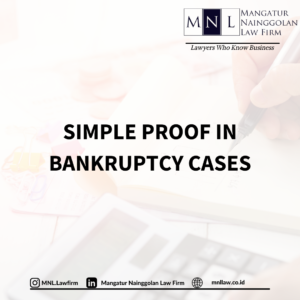
A simple proof in a bankruptcy petition involves proving the existence of two or more creditors and the presence of debts that have matured and are recoverable but have not been paid in full by the debtor.
One way to prove the existence of a debt is for the creditor to demonstrate that they have issued a demand to the debtor for payment of their obligation, but the debtor has not made the payment. Alternatively, the creditor can prove that, beyond the agreed-upon deadline for payment of the obligation (debt), the debtor has still not made the payment. If proving the existence of the debt is complex, difficult, or contentious, it does not meet the criteria for simple proof.
The requirement for simple proof is one of the conditions that must be met for a bankruptcy petition to be granted. “Simple proof” is regulated and described in Article 8, paragraph (4) of the Bankruptcy Law as follows:
“A bankruptcy declaration petition must be granted if there are facts or circumstances that are proven in a straightforward manner that the requirements for declaring bankruptcy as referred to in Article 2, paragraph (1) have been fulfilled.”
In principle, the provision in this article is intended to streamline the bankruptcy petition resolution process.
Therefore, with the provision in Article 8, paragraph (4) of the Bankruptcy Law:
-
- Creditors need to provide clear evidence that the debtor has a debt that has matured and is recoverable.
- The debtor, in this case, the respondent in the bankruptcy petition, is proven to have debts that cannot be paid to two or more creditors without the need to consider other variables for proof.
